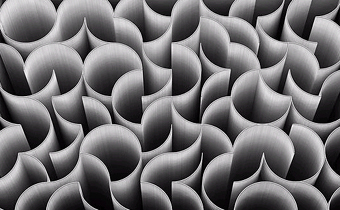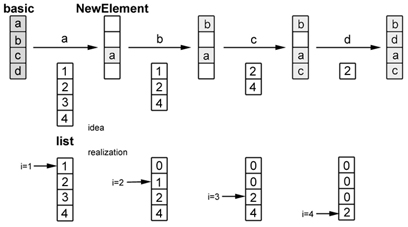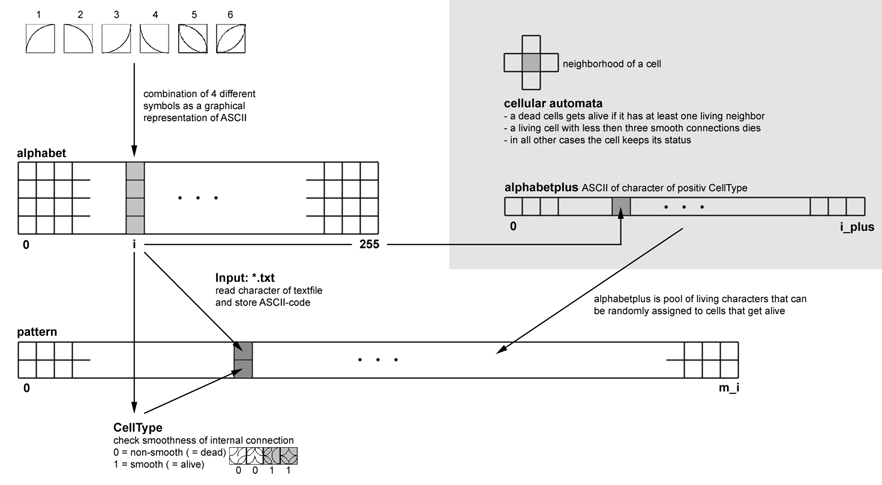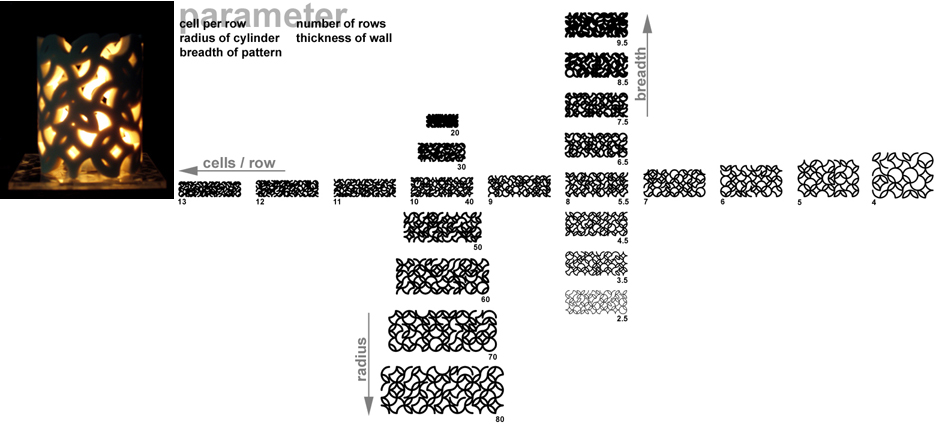 |
|
||||||||||

| MAS ETH ARCH/CAAD - 2005/06 - STUDENT PAGES Master of Advanced Studies in Architecture, Specialization in Computer Aided Architectural Design | 065-0005/6 Supervision: Prof. Dr. Ludger Hovestadt, Philipp Schaerer Chair of CAAD, ETH Zurich Toni Kotnik Module 1: Scripting|Assignment 2 programming of pattern and further development 
programming of pattern The basic idea of how to generate all possible permutations of the 4 elements (compare Assignment 1) was the parallel use of an array list of all possible positions for the next entry. A pointer and an infill of zeros was introduced to avoid a dynamic array. The generation of a new permutation is then carried out in the procedure Generate and the function Reorder. With the function NewPattern the generated permuation is compared to the list of already exiting permutations, added to it if the pattern is new and printed out by procedure PrintOut . After generating all 24 different permutations the programm terminats. 
PROCEDURE pattern;
VAR
i,j : INTEGER;
element : ARRAY[1..4] OF INTEGER; (* basic and generated one*)
pattern : ARRAY[1..24,1..4] OF INTEGER; (* possible pattern *)
(* --- function for reordering of the list of available positions --- *)
FUNCTION Reorder(olist:ARRAY[1..4] OF INTEGER):ARRAY[1..4] OF INTEGER;
VAR
i : INTEGER; (* counter *)
s : INTEGER; (* storage *)
BEGIN
FOR i:=4 DOWNTO 2 DO
IF olist[i]=0 THEN
BEGIN
olist[i]:=olist[i-1];
olist[i-1]:=0;
END;
Reorder:=olist;
END;
(* --- procedure to generate a permutation of the basic element --- *)
PROCEDURE Generate(VAR NewElement:ARRAY[1..4] OF INTEGER);
VAR
i : INTEGER; (* counter *)
basic : ARRAY[1..4] OF INTEGER; (* basic element*)
list : ARRAY[1..4] OF INTEGER; (* list of available positions *)
r,n : INTEGER; (* range and generated random number *)
lpos : INTEGER; (* position in list *)
BEGIN
FOR i:=1 TO 4 DO (* initialization of basic elements and available positions *)
BEGIN
basic[i]:=i;
list[i]:=i;
END;
r:=3;
FOR i:=1 TO 4 DO (* generate a pattern *)
BEGIN
n:=i+Random*r; (* take an available position in the list *)
lpos:=list[n]; (* read the corresponding entry *)
list[n]:=0; (* erase entry *)
NewElement[lpos]:=basic[i]; (* place basic element at that position *)
list := Reorder(list);
r:=r-1;
END;
END;
(* ---- function to compare the generated element with existing patterns --- *)
FUNCTION NewPattern(list: ARRAY[1..4] OF INTEGER; n: INTEGER):BOOLEAN;
VAR
i,j : INTEGER; (* counter *)
t : INTEGER;
test : BOOLEAN;
BEGIN
test:=TRUE;
FOR i:=1 TO n DO
BEGIN
t:=0;
FOR j:=1 TO 4 DO
IF pattern[i,j]=list[j] THEN t:=t+1;
IF t=4 THEN test:=FALSE;
END;
NewPattern:=test;
END;
(* --- print the new pattern --- *)
PROCEDURE PrintOut(NewElement:ARRAY[1..4] OF INTEGER; i: INTEGER);
VAR
j: INTEGER; (* counter *)
h,v,r,c : INTEGER; (* horizontal and vertical shift for print out *)
BEGIN
FillPat(0);
PenSize(10);
r:=0;c:=i;
WHILE c>6 DO (* calculate the row r and colummn i of the element *)
BEGIN
r:=r+1;
c:=c-6;
END;
FOR j:= 1 TO 4 DO
BEGIN
IF j<3 THEN v:=0 ELSE v:=1; (* vertical position in a 2x2-array *)
IF (j MOD 2 = 1) THEN h:=0 ELSE h:=1; (* horizontal position in a 2x2-array *)
ArcByCenter(10*c+5*h,5*v+10*r,5,0,90);
Rotate(90*NewElement[j]);
ReDrawAll;
DSelectAll;
END;
END;
(* --- main body --- *)
BEGIN
i:=1;
REPEAT
Generate(element);
IF NewPattern(element,i-1) THEN
BEGIN
FOR j:=1 TO 4 DO
pattern[i,j]:=element[j];
PrintOut(element,i);
i:=i+1;
END;
UNTIL i=25;
END;
RUN(pattern);

further development  animation (1.1 MB)
animation (1.1 MB)
Using six elements to choose from the alphabet of 24 different letters out of four elements was then extended to an alphabet of 360 possible letters. This way, the whole ASCII-table could be coded and used to generate a pattern by reading a textfile sequentially. In order to receive a highly connected pattern, that is a pattern with smooth pathes along the arcs, the translated textfile was used as input for a cellular automata with the goal to optimize the amount of smooth connections. For this purpose the function CellType was developed to obtain a measure for the ability to move through the cell along a smooth path. The function checks the connection at the center point of each cell and returns 0 if it is non-smooth and 1 otherwise. Similarly, the function CCheck calculates the amount of smooth connections between a cell and its surrounding neighborhood. The automata then takes up the type of a cell as main criteria: a cell of type 0 is regarded as dead, a cell of type 1 as alive. In every generation the automata replaces non-isolated dead cells or badly connected living cells by a new candidate out of a pool of cells of type one. This way, the pattern improves gradually. 
The expression of the final object depends essentially on the density of the pattern. This particular feature can be influenced by three of the five paramters. With the breadth of the arcs the density of the pattern can be adjusted directly. The radius and the amount of cells per row have an influence on the size of each cell, therewith affecting the density of the pattern and the height of the cylinder indirectly. These paramaters act diametrically: an increasing radius leads to an increasing cell size, hence to a decreasing density; an increasing amount of cells per row leads to a decreasing cell size and therefore to an increasing density. With the two remaining parameters the number of rows and the thickness of the wall can be adjusted. 
PROCEDURE pattern1;
CONST
columns = 8; (* cells per row *)
rows = 3; (* number of layers of cylinder *)
radius = 80; (* radius on the outside of cylinder *)
thickness = 7.5;(* breadth of arcs *)
depth = 8; (* wall thickness of cylinder *)
VAR
i,i_plus,i_p,j,l,nc,cc,k : INTEGER;
max_i,m_i,cr : INTEGER;
col_i,row_i : REAL;
InputText,data : STRING;
letter : CHAR;
lnumber,loops : INTEGER;
element : ARRAY[1..4] OF INTEGER;
alphabet : ARRAY[0..255,1..4] OF INTEGER;
alphabetplus : ARRAY[0..255] OF INTEGER;
GoOn : BOOLEAN;
pattern, patternTemp : DYNARRAY[,] OF INTEGER;
d,factor : REAL;
alpha,beta, base,height : REAL;
hl : HANDLE;
r,g,b : LONGINT;
(* --- reordering of the list of available positions --- *)
FUNCTION Reorder(olist:ARRAY[1..4] OF INTEGER):ARRAY[1..4] OF INTEGER;
VAR
i : INTEGER; (* counter *)
s : INTEGER; (* storage *)
BEGIN
FOR i:=4 DOWNTO 2 DO
IF olist[i]=0 THEN
BEGIN
olist[i]:=olist[i-1]; (* shift content down ... *)
olist[i-1]:=0; (* ... and fill up rest with zero *)
END;
Reorder:=olist;
END;
(* --- generate a permutation of basic elements --- *)
PROCEDURE Generate(VAR NewElement:ARRAY[1..4] OF INTEGER);
VAR
i : INTEGER; (* counter *)
basic : ARRAY[1..6] OF INTEGER; (* basic element*)
list : ARRAY[1..4] OF INTEGER; (* list of available positions *)
r,n : INTEGER; (* range and generated random number *)
lpos : INTEGER; (* position in list *)
BEGIN
FOR i:=1 TO 6 DO basic[i]:=i; (* six different elements *)
n:=1+random*5; (* choose one ... *)
FOR i:=n TO 5 DO basic[i]:=basic[i+1]; (* ... erase it out of the list of available elements *)
n:=1+random*4; (* chose another one ... *)
FOR i:=n TO 4 DO basic[i]:=basic[i+1]; (* ... erase it out of the list of available elements = basic[1] ... basic[4] *)
FOR i:=1 TO 4 DO list[i]:=i;
r:=3;
FOR i:=1 TO 4 DO (* generate a pattern *)
BEGIN
n:=i+Random*r; (* take an available position in the list *)
lpos:=list[n]; (* read the corresponding entry *)
list[n]:=0; (* erase entry *)
NewElement[lpos]:=basic[i]; (* place basic element at that position *)
list := Reorder(list);
r:=r-1;
END;
END;
(* ---- compare the generated element with existing patterns --- *)
FUNCTION NewPattern(list: ARRAY[1..4] OF INTEGER; n: INTEGER):BOOLEAN;
VAR
i,j : INTEGER;
t : INTEGER;
test : BOOLEAN;
BEGIN
test:=TRUE;
FOR i:=1 TO n DO
BEGIN
t:=0; (* amount of equal entries *)
FOR j:=1 TO 4 DO
IF alphabet[i,j]=list[j] THEN t:=t+1;
IF t=4 THEN test:=FALSE; (* all entries equal = permutation exists already *)
END;
NewPattern:=test;
END;
(* --- print element using arcs --- *)
PROCEDURE PrintOutArc(NewElement:ARRAY[1..4] OF INTEGER; i: INTEGER);
VAR
j: INTEGER;
h,v,r,c : INTEGER; (* horizontal and vertical shift for print out *)
BEGIN
FillBack(0,0,0);
PenFore(0,0,0);
r:=0;c:=i;
WHILE c>columns DO (* calculate the row r and colummn i of the element *)
BEGIN
r:=r+1;
c:=c-columns;
END;
FOR j:= 1 TO 4 DO
BEGIN
IF j<3 THEN v:=0 ELSE v:=1; (* vertical position in a 2x2-array *)
IF (j MOD 2 = 1) THEN h:=0 ELSE h:=1; (* horizontal position in a 2x2-array *)
CASE NewElement[j] OF
1..4:BEGIN
FillPat(0);
ArcByCenter(10*c+5*h,5*v+10*r,5,0,90);
Rotate(-90*NewElement[j]);
END;
5:BEGIN
FillPat(0);
ArcByCenter(10*c+5*h,5*v+10*r,5,0,90);
Duplicate(0,0);
Rotate(180);
END;
6:BEGIN
FillPat(0);
ArcByCenter(10*c+5*h,5*v+10*r,5,0,90);
Rotate(90);
Duplicate(0,0);
Rotate(180);
END;
END;
ReDraw;
DSelectAll;
END;
END;
(* --- arc with breadth --- *)
PROCEDURE BasicElement2d(n:INTEGER);
VAR
ptX,ptY,arcRadius : REAL;
vertexType,test : INTEGER;
BEGIN
ClosePoly;
BeginPoly; (* define element as polyline *)
AddPoint(base-d,0); (* base = dimension of square; d = amount of overlapping with next cell *)
AddPoint(base-d,-d);
AddPoint(base+d,-d);
AddPoint(base+d,0);
AddPoint(base+d,base+d);
AddPoint(0,base+d);
AddPoint(-d,base+d);
AddPoint(-d,base-d);
AddPoint(0,base-d);
AddPoint(base-d,base-d);
EndPoly;
GetPolylineVertex(LNewObj,2,ptX,ptY,vertexType,arcRadius); (* pick vertex ... *)
SetPolylineVertex(LNewObj,2,ptX,ptY,3,d,true); (* ... and make it round *)
GetPolylineVertex(LNewObj,3,ptX,ptY,vertexType,arcRadius);
SetPolylineVertex(LNewObj,3,ptX,ptY,3,d,true);
GetPolylineVertex(LNewObj,5,ptX,ptY,vertexType,arcRadius);
SetPolylineVertex(LNewObj,5,ptX,ptY,3,base+d,true);
GetPolylineVertex(LNewObj,7,ptX,ptY,vertexType,arcRadius);
SetPolylineVertex(LNewObj,7,ptX,ptY,3,d,true);
GetPolylineVertex(LNewObj,8,ptX,ptY,vertexType,arcRadius);
SetPolylineVertex(LNewObj,8,ptX,ptY,3,d,true);
GetPolylineVertex(LNewObj,10,ptX,ptY,vertexType,arcRadius);
SetPolylineVertex(LNewObj,10,ptX,ptY,3,base-d,true);
RotatePoint(base/2,base/2,90*n);
END;
(* --- print arcs with thickness --- *)
PROCEDURE PrintOutArcThick(NewElement:ARRAY[1..4] OF INTEGER; i: INTEGER);
VAR
j: INTEGER; (* counter *)
h,v,r,c : INTEGER; (* horizontal and vertical shift for print out *)
a,b,inter : HANDLE;
BEGIN
FillBack(0,0,0);
PenFore(0,0,0);
FillPat(1);
r:=0;c:=i;
WHILE c>columns DO (* calculate the row r and colummn i of the element *)
BEGIN
r:=r+1;
c:=c-columns;
END;
FOR j:= 1 TO 4 DO
BEGIN
IF j<3 THEN v:=0 ELSE v:=1; (* vertical position in a 2x2-array *)
IF (j MOD 2 = 1) THEN h:=0 ELSE h:=1; (* horizontal position in a 2x2-array *)
CASE NewElement[j] OF
1..4:BEGIN
BasicElement2d(NewElement[j]);
MoveObjs(2*base*c+base*h,base*v+2*base*r,FALSE,FALSE);
DSelectAll;
END;
5:BEGIN
BasicElement2d(2);
MoveObjs(2*base*c+base*h,base*v+2*base*r,FALSE,FALSE);
DSelectAll;
BasicElement2d(4);
MoveObjs(2*base*c+base*h,base*v+2*base*r,FALSE,FALSE);
DSelectAll;
END;
6:BEGIN
BasicElement2d(1);
MoveObjs(2*base*c+base*h,base*v+2*base*r,FALSE,FALSE);
DSelectAll;
BasicElement2d(3);
MoveObjs(2*base*c+base*h,base*v+2*base*r,FALSE,FALSE);
DSelectAll;
END;
END;
ReDraw;
DSelectAll;
END;
END;
(* --- print pattern in bw-blocks --- *)
PROCEDURE PrintOutColor(NewElement:ARRAY[1..4] OF INTEGER; i: INTEGER);
VAR
j: INTEGER; (* counter *)
h,v,r,c : INTEGER; (* horizontal and vertical shift for print out *)
BEGIN
FillPat(1);
r:=0;c:=i;
WHILE c>columns DO (* calculate the row r and colummn i of the element *)
BEGIN
r:=r+1;
c:=c-columns;
END;
IF NewElement[1]<>0
THEN FillBack(0,0,0)
ELSE FillBack(65535,65535,65535);
Rect(10*c,10*r,10*c+10,10*r+10);
ReDraw;
DSelectAll;
END;
(* --- calculate the celltype --- *)
FUNCTION CellType(NewElement:ARRAY[1..4] OF INTEGER):INTEGER;
VAR
t : INTEGER;
BEGIN
t:=0; (* count number of bad connections *)
CASE NewElement[1] OF (* check list of good combinations *)
1:IF NOT ((((NewElement[4]=3) OR (NewElement[4]=6)) OR (NewElement[3]=4)) OR (NewElement[3]=5)) THEN t:=t+1;
3:IF NOT ((((NewElement[4]=1) OR (NewElement[4]=6)) OR (NewElement[2]=4)) OR (NewElement[2]=5)) THEN t:=t+1;
6:IF NOT ((((((NewElement[4]=1) OR (NewElement[4]=3)) OR (NewElement[2]=4)) OR (NewElement[2]=5)) OR (NewElement[3]=4)) OR (NewElement[3]=5)) THEN t:=t+1;
END;
CASE NewElement[2] OF
2:IF NOT ((((NewElement[3]=4) OR (NewElement[3]=5)) OR (NewElement[4]=3)) OR (NewElement[4]=6)) THEN t:=t+1;
4:IF NOT ((((NewElement[3]=2) OR (NewElement[3]=5)) OR (NewElement[2]=3)) OR (NewElement[2]=6)) THEN t:=t+1;
5:IF NOT ((((((NewElement[3]=2) OR (NewElement[3]=4)) OR (NewElement[1]=3)) OR (NewElement[1]=6)) OR (NewElement[4]=3)) OR (NewElement[4]=6)) THEN t:=t+1;
END;
CASE NewElement[3] OF
2:IF NOT ((((NewElement[2]=4) OR (NewElement[2]=5)) OR (NewElement[4]=1)) OR (NewElement[4]=6)) THEN t:=t+1;
4:IF NOT ((((NewElement[2]=2) OR (NewElement[2]=5)) OR (NewElement[1]=1)) OR (NewElement[1]=6)) THEN t:=t+1;
5:IF NOT ((((((NewElement[2]=2) OR (NewElement[2]=4)) OR (NewElement[1]=1)) OR (NewElement[1]=6)) OR (NewElement[4]=1)) OR (NewElement[4]=6)) THEN t:=t+1;
END;
CASE NewElement[4] OF
1:IF NOT ((((NewElement[1]=3) OR (NewElement[1]=6)) OR (NewElement[3]=2)) OR (NewElement[3]=5)) THEN t:=t+1;
3:IF NOT ((((NewElement[1]=1) OR (NewElement[1]=6)) OR (NewElement[2]=2)) OR (NewElement[2]=5)) THEN t:=t+1;
6:IF NOT ((((((NewElement[1]=1) OR (NewElement[1]=3)) OR (NewElement[2]=2)) OR (NewElement[2]=5)) OR (NewElement[3]=2)) OR (NewElement[3]=5)) THEN t:=t+1;
END;
IF t>0
THEN CellType:=0
ELSE CellType:=1; (* CellType 1 = good flow through cell *)
END;
(* --- check for living cells in the neighborhood --- *)
Procedure NCheck(i:INTEGER; VAR n:INTEGER);
VAR
seed : INTEGER;
BEGIN
seed:=0; (* count number of living neighbors *)
IF (i<m_i) THEN (* does neighbor exist? *)
BEGIN
IF (pattern[i+1,2]=1) THEN seed:=seed+1;
END;
IF (i>1) THEN
BEGIN
IF (pattern[i-1,2]=1) THEN seed:=seed+1;
END;
IF (i+columns<=m_i) THEN
BEGIN
IF (pattern[i+columns,2]=1) THEN seed:=seed+1;
END;
IF (i-columns>0) THEN
BEGIN
IF (pattern[i-columns,2]=1) THEN seed:=seed+1;
END;
n:=seed;
END;
(* --- connection between cells smooth? --- *)
FUNCTION SmoothConnect(a,b,pos:INTEGER):BOOLEAN;
VAR
t : BOOLEAN;
ct : INTEGER;
element : ARRAY[1..4] OF INTEGER;
BEGIN
t:=FALSE;
CASE a OF (* check list of good combinations *)
1: CASE pos OF
1,5: IF ((b=3) OR (b=6)) THEN t:=TRUE;
6 : IF ((b=4) OR (b=5)) THEN t:=TRUE;
8 : IF ((b=2) OR (b=5)) THEN t:=TRUE;
END;
2: CASE pos OF
3,7: IF ((b=4) OR (b=5)) THEN t:=TRUE;
4 : IF ((b=1) OR (b=6)) THEN t:=TRUE;
6 : IF ((b=3) OR (b=6)) THEN t:=TRUE;
END;
3: CASE pos OF
1,5: IF ((b=1) OR (b=6)) THEN t:=TRUE;
2 : IF ((b=2) OR (b=5)) THEN t:=TRUE;
4 : IF ((b=4) OR (b=5)) THEN t:=TRUE;
END;
4: CASE pos OF
3,7: IF ((b=2) OR (b=5)) THEN t:=TRUE;
2 : IF ((b=1) OR (b=6)) THEN t:=TRUE;
8 : IF ((b=3) OR (b=6)) THEN t:=TRUE;
END;
5: CASE pos OF
3,7: IF (((b=2) OR (b=4)) OR (b=5)) THEN t:=TRUE;
2,4: IF ((b=1) OR (b=6)) THEN t:=TRUE;
6,8: IF ((b=3) OR (b=6)) THEN t:=TRUE;
END;
6: CASE pos OF
1,5: IF (((b=1) OR (b=3)) OR (b=6)) THEN t:=TRUE;
2,8: IF ((b=2) OR (b=5)) THEN t:=TRUE;
4,6: IF ((b=4) OR (b=5)) THEN t:=TRUE;
END;
END;
SmoothConnect:=t;
END;
(* --- check amount of existing external connections --- *)
PROCEDURE CCheck (i:INTEGER; VAR n:INTEGER);
VAR
c : INTEGER;
BEGIN
c:=0; (* count number of smooth connections *)
IF i>1 THEN
IF pattern[i-1,2]=1 THEN
BEGIN
IF SmoothConnect(alphabet[pattern[i,1],1],alphabet[pattern[i-1,1],2],8) THEN c:=c+1;
IF SmoothConnect(alphabet[pattern[i,1],1],alphabet[pattern[i-1,1],4],7) THEN c:=c+1;
IF SmoothConnect(alphabet[pattern[i,1],3],alphabet[pattern[i-1,1],4],8) THEN c:=c+1;
IF SmoothConnect(alphabet[pattern[i,1],3],alphabet[pattern[i-1,1],2],1) THEN c:=c+1;
END;
IF i<m_i THEN
IF pattern[i+1,2]=1 THEN
BEGIN
IF SmoothConnect(alphabet[pattern[i,1],2],alphabet[pattern[i+1,1],1],4) THEN c:=c+1;
IF SmoothConnect(alphabet[pattern[i,1],2],alphabet[pattern[i+1,1],3],5) THEN c:=c+1;
IF SmoothConnect(alphabet[pattern[i,1],4],alphabet[pattern[i+1,1],3],4) THEN c:=c+1;
IF SmoothConnect(alphabet[pattern[i,1],4],alphabet[pattern[i+1,1],1],3) THEN c:=c+1;
END;
IF i+columns<=m_i THEN
IF pattern[i+columns,2]=1 THEN
BEGIN
IF SmoothConnect(alphabet[pattern[i,1],3],alphabet[pattern[i+columns,1],1],6) THEN c:=c+1;
IF SmoothConnect(alphabet[pattern[i,1],3],alphabet[pattern[i+columns,1],2],5) THEN c:=c+1;
IF SmoothConnect(alphabet[pattern[i,1],4],alphabet[pattern[i+columns,1],2],6) THEN c:=c+1;
IF SmoothConnect(alphabet[pattern[i,1],4],alphabet[pattern[i+columns,1],1],7) THEN c:=c+1;
END;
IF i-columns>0 THEN
IF pattern[i-columns,2]=1 THEN
BEGIN
IF SmoothConnect(alphabet[pattern[i,1],1],alphabet[pattern[i-columns,1],3],2) THEN c:=c+1;
IF SmoothConnect(alphabet[pattern[i,1],1],alphabet[pattern[i-columns,1],4],3) THEN c:=c+1;
IF SmoothConnect(alphabet[pattern[i,1],2],alphabet[pattern[i-columns,1],4],2) THEN c:=c+1;
IF SmoothConnect(alphabet[pattern[i,1],2],alphabet[pattern[i-columns,1],3],1) THEN c:=c+1;
END;
n:=c;
END;
(* --- Basic form of final project --- *)
FUNCTION BasicForm:HANDLE;
VAR
r : REAL;
f1,f2,f3 : HANDLE;
test : INTEGER;
ptX,ptY,arcRadius : REAL;
vertexType : INTEGER;
BEGIN
r:=radius;
BeginMXtrd(0,3*base); (* define cylinder as subtraction of two solids *)
BeginPoly;
AddPoint(-r,r);
AddPoint(-r,-r);
AddPoint(r,-r);
AddPoint(r,r);
EndPoly;
GetPolylineVertex(LNewObj,1,ptX,ptY,vertexType,arcRadius);
SetPolylineVertex(LNewObj,1,ptX,ptY,3,r,true);
GetPolylineVertex(LNewObj,2,ptX,ptY,vertexType,arcRadius);
SetPolylineVertex(LNewObj,2,ptX,ptY,3,r,true);
GetPolylineVertex(LNewObj,3,ptX,ptY,vertexType,arcRadius);
SetPolylineVertex(LNewObj,3,ptX,ptY,3,r,true);
GetPolylineVertex(LNewObj,4,ptX,ptY,vertexType,arcRadius);
SetPolylineVertex(LNewObj,4,ptX,ptY,3,r,true);
BeginPoly;
AddPoint(-r,r);
AddPoint(-r,-r);
AddPoint(r,-r);
AddPoint(r,r);
EndPoly;
GetPolylineVertex(LNewObj,1,ptX,ptY,vertexType,arcRadius);
SetPolylineVertex(LNewObj,1,ptX,ptY,3,r,true);
GetPolylineVertex(LNewObj,2,ptX,ptY,vertexType,arcRadius);
SetPolylineVertex(LNewObj,2,ptX,ptY,3,r,true);
GetPolylineVertex(LNewObj,3,ptX,ptY,vertexType,arcRadius);
SetPolylineVertex(LNewObj,3,ptX,ptY,3,r,true);
GetPolylineVertex(LNewObj,4,ptX,ptY,vertexType,arcRadius);
SetPolylineVertex(LNewObj,4,ptX,ptY,3,r,true);
EndMXtrd;
f1:=LNewObj;
DSelectAll;
r:=radius-depth;
BeginMXtrd(0,3*base);
BeginPoly;
AddPoint(-r,r);
AddPoint(-r,-r);
AddPoint(r,-r);
AddPoint(r,r);
EndPoly;
GetPolylineVertex(LNewObj,1,ptX,ptY,vertexType,arcRadius);
SetPolylineVertex(LNewObj,1,ptX,ptY,3,r,true);
GetPolylineVertex(LNewObj,2,ptX,ptY,vertexType,arcRadius);
SetPolylineVertex(LNewObj,2,ptX,ptY,3,r,true);
GetPolylineVertex(LNewObj,3,ptX,ptY,vertexType,arcRadius);
SetPolylineVertex(LNewObj,3,ptX,ptY,3,r,true);
GetPolylineVertex(LNewObj,4,ptX,ptY,vertexType,arcRadius);
SetPolylineVertex(LNewObj,4,ptX,ptY,3,r,true);
BeginPoly;
AddPoint(-r,r);
AddPoint(-r,-r);
AddPoint(r,-r);
AddPoint(r,r);
EndPoly;
GetPolylineVertex(LNewObj,1,ptX,ptY,vertexType,arcRadius);
SetPolylineVertex(LNewObj,1,ptX,ptY,3,r,true);
GetPolylineVertex(LNewObj,2,ptX,ptY,vertexType,arcRadius);
SetPolylineVertex(LNewObj,2,ptX,ptY,3,r,true);
GetPolylineVertex(LNewObj,3,ptX,ptY,vertexType,arcRadius);
SetPolylineVertex(LNewObj,3,ptX,ptY,3,r,true);
GetPolylineVertex(LNewObj,4,ptX,ptY,vertexType,arcRadius);
SetPolylineVertex(LNewObj,4,ptX,ptY,3,r,true);
EndMXtrd;
f2:=LNewObj;
DSelectAll;
test:=SubtractSolid(f1,f2,f3);
Rotate3D(-90,0,0);
Move3D(0,-base,0);
BasicForm:=f3;
DSelectAll;
END;
(* --- construction of Basic element --- *)
PROCEDURE BasicElement3d(n:INTEGER);
VAR
test : INTEGER;
h1,h2,h3 : HANDLE;
factor_top,factor_bottom,top,bottom: REAL;
BEGIN
bottom:=radius-1.5*depth; (* calculate factors for extrusion *)
factor_bottom:=bottom/radius;
top:=1.5*radius;
factor_top:=top/radius;
BeginMXtrd(top,bottom); (* extrude object as cone *)
BasicElement2d(n);
Scale(factor_top,factor_top);
DSelectAll;
BasicElement2d(n);
Scale(factor_bottom,factor_bottom);
DSelectAll;
EndMXtrd;
SetSelect(LNewObj);
Move3D(-base/2,0,0);
h1:=LNewObj;
h2:=BasicForm;
test:=IntersectSolid(h1,h2,h3);
END;
(* --- print the pattern in 3d --- *)
PROCEDURE PrintOutWall(NewElement:ARRAY[1..4] OF INTEGER; i: INTEGER);
VAR
j,test: INTEGER; (* counter *)
h,v,r,c,ref : INTEGER; (* horizontal and vertical shift for print out *)
hnew : HANDLE;
f1,f2,f3 : LONGINT;
BEGIN
FillPat(1);
ColorIndexToRGB(19,f1,f2,f3);
FillBack(f1,f2,f3);
FillFore(f1,f2,f3);
r:=0;c:=i;
WHILE c>columns DO (* calculate the row r and colummn i of the element *)
BEGIN
r:=r+1;
c:=c-columns;
END;
FOR j:= 1 TO 4 DO
BEGIN
IF j<3 THEN v:=0 ELSE v:=1; (* vertical position in a 2x2-array *)
IF (j MOD 2 = 1) THEN h:=0 ELSE h:=1; (* horizontal position in a 2x2-array *)
FillPat(1);
CASE NewElement[j] OF
1..4:BEGIN
BasicElement3d(NewElement[j]);
MoveObjs(0,base*v+2*base*r,FALSE,FALSE);
Rotate3D(0,alpha*c+alpha/2*h,0);
DSelectAll;
END;
5:BEGIN
BasicElement3d(2);
MoveObjs(0,base*v+2*base*r,FALSE,FALSE);
Rotate3D(0,alpha*c+alpha/2*h,0);
DSelectAll;
BasicElement3d(4);
MoveObjs(0,base*v+2*base*r,FALSE,FALSE);
Rotate3D(0,alpha*c+alpha/2*h,0);
DSelectAll;
END;
6:BEGIN
BasicElement3d(1);
MoveObjs(0,base*v+2*base*r,FALSE,FALSE);
Rotate3D(0,alpha*c+alpha/2*h,0);
DSelectAll;
BasicElement3d(3);
MoveObjs(0,base*v+2*base*r,FALSE,FALSE);
Rotate3D(0,alpha*c+alpha/2*h,0);
DSelectAll;
END;
END;
ReDraw;
FillPat(0);
END;
END;
(* --- main body --- *)
BEGIN
SelectAll;
DeleteObjs;
DoMenuTextByName('Standard Views',1); (* top view *)
(* --- generate alphabet --- *)
Message('computer generates the alphabet');
i:=0;i_plus:=0;
REPEAT (* generate the alphabet *)
Generate(element);
IF NewPattern(element,i-1) THEN
BEGIN
FOR j:=1 TO 4 DO alphabet[i,j]:=element[j];
IF CellType(element)>0
THEN
BEGIN
i_plus:=i_plus+1;
alphabetplus[i_plus]:=i;
END;
i:=i+1;
END;
UNTIL i=256;
(* --- read length of data --- *)
GetFile(InputText);
max_i:=0;
Open(InputText);
WHILE NOT Eof(InputText) DO
BEGIN
Readln(data);
max_i:=max_i+Len(data);
END;
Close(InputText);
col_i:=Trunc(Sqrt(max_i))+1; (* display input close to square *)
row_i:=1;l:=max_i;
WHILE l > col_i DO
BEGIN
l:=l-col_i;
row_i:=row_i+1;
END;
(* --- generate the print out using arcs --- *)
m_i:=col_i*row_i;cr:=columns*rows;
IF m_i<cr THEN m_i:=cr;
ALLOCATE pattern[1..m_i,1..2];
ALLOCATE patternTemp[1..m_i,1..2];
Open(InputText);
For i:= 1 TO m_i DO
BEGIN
IF i<=max_i
THEN BEGIN
Read(letter);
lnumber:=Ord(letter);
FOR j:=1 TO 4 DO element[j]:=alphabet[lnumber,j];
END
ELSE FOR j:=1 TO 4 DO element[j]:=alphabet[32,j]; (* add ' ' to make field a rectangle *)
PrintOutArc(element,i);
pattern[i,1]:=lnumber;
pattern[i,2]:=CellType(element);
END;
Close(InputText);
hl:=GetLayer(LNewObj);
SetLayerRenderMode(hl,0,FALSE,TRUE); (* wireframe *)
(* --- generate the print out using colors --- *)
loops:=50;
SelectAll;
DeleteObjs;
For i:= 1 TO m_i DO (* generate input for automata, display type of each cell *)
BEGIN
IF i<=max_i
THEN BEGIN
lnumber:=pattern[i,1];
FOR j:=1 TO 4 DO element[j]:=alphabet[lnumber,j];
END
ELSE FOR j:=1 TO 4 DO element[j]:=alphabet[32,j];
IF CellType(element)=0
THEN BEGIN
FOR j:=1 TO 4 DO element[j]:=0;
pattern[i,2]:=0;
END;
PrintOutColor(element,i);
END;
Close(InputText);
(* --- calculate new pattern using cellular automata --- *)
FOR l:=1 TO loops DO (* start automata *)
BEGIN
Message('l=',l);
For i:=1 TO m_i DO
BEGIN
NCheck(i,nc);
CCheck(i,cc);
CASE pattern[i,2] OF
0: IF nc>0
THEN BEGIN
i_p:=trunc(1+Random*(i_plus-1)); (* replace cell by a randomly picked cell of type 1 *)
patternTemp[i,1]:=alphabetplus[i_p];
FOR j:=1 TO 4 DO element[j]:=alphabet[patternTemp[i,1],j];
patternTemp[i,2]:=CellType(element);
END;
1:IF cc<3 THEN patternTemp[i,2]:=0;
END;
IF patternTemp[i,2]=1
THEN BEGIN
FOR j:=1 TO 4 DO element[j]:=alphabet[patternTemp[i,1],j];
PrintOutColor(element,i)
END
ELSE BEGIN
FOR j:=1 TO 4 DO element[j]:=0;
PrintOutColor(element,i);
END;
END;
pattern:=patternTemp;
END;
SelectAll;
DeleteObjs;
(* calculate data *)
m_i:=columns*rows;
d:=thickness/2;
alpha:=pi/columns;
beta:=alpha/2;
height:=radius*Cos(alpha/2);
base:=2*radius*sin(alpha/2);
alpha:=360/columns;
(* --- printout 2d --- *)
FOR i:=1 TO m_i DO
BEGIN
FOR j:=1 TO 4 DO element[j]:=alphabet[patternTemp[i,1],j];
PrintOutArcThick(element,i);
END;
DSelectAll;
(* --- printout 3d --- *)
GoOn:=YNDialog('Do you wish to continue?');
IF GoOn
THEN BEGIN
SelectAll;
DeleteObjs;
FOR i:= 1 TO m_i DO
BEGIN
FOR j:=1 TO 4 DO element[j]:=alphabet[pattern[i,1],j];
PrintOutWall(element,i);
END;
END;
DoMenuTextByName('Standard Views',8); (* top right *)
hl:=GetLayer(LNewObj);
SetLayerRenderMode(hl,12,FALSE,TRUE); (* quick render *)
END;
RUN(pattern1);
| ||||
This website has been archived and is no longer maintained.
